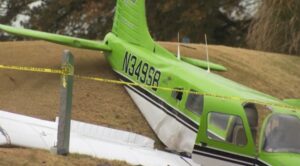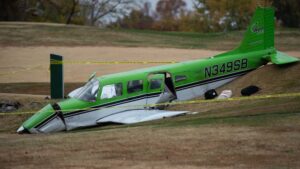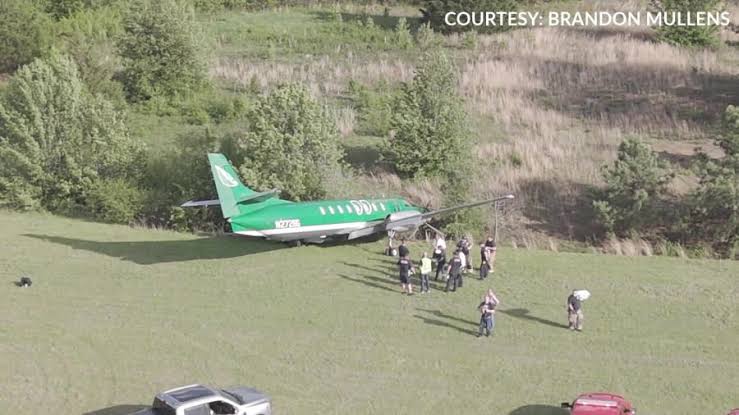Breaking: Plane crash at North Little Rock Airport caused by landing gear failure
On Thursday afternoon, a plane crash occurred at the North Little Rock Municipal Airport in Arkansas, prompting a swift response from emergency personnel. The North Little Rock Fire Department reported receiving the initial alert about the incident at approximately 4:10 p.m. Officials quickly mobilized to the scene, where a small aircraft had experienced a significant mechanical failure during its landing.
The aircraft in question belonged to Key Lime Air, a Denver-based regional airline. In an official statement released by the company, representatives confirmed that the crash was caused by the collapse of the plane’s landing gear. The aircraft, identified as a Swearingen Metroliner III, had been performing a routine repositioning flight. This particular flight did not involve any passengers, as it was returning from a completed training mission.

According to Key Lime Air, the only individuals aboard the flight were two pilots. Both crew members managed to evacuate the plane safely without sustaining any injuries. Furthermore, officials confirmed that there were no casualties or injuries reported on the ground as a result of the crash.
The airline emphasized its commitment to safety and transparency in the aftermath of the incident. In accordance with aviation protocol, Key Lime Air promptly reported the crash to the Federal Aviation Administration (FAA) as well as the National Transportation Safety Board (NTSB). Both federal agencies will now begin their respective investigations to determine the root causes of the mechanical failure and any contributing factors.

The spokesperson from Key Lime Air reiterated the company’s dedication to fully cooperating with these investigations. They stressed that understanding the exact circumstances that led to the landing gear malfunction is a top priority for the airline. This kind of inquiry is standard procedure after aviation incidents and helps both regulators and operators ensure that similar occurrences can be prevented in the future.
The Swearingen Metroliner III, the model involved in the incident, is a twin-engine turboprop aircraft commonly used by regional carriers for short-haul flights. While this particular plane was not carrying passengers, its use in both cargo and passenger services is well-documented across the industry. These types of aircraft are known for their durability and reliability, although, like all mechanical systems, they can experience failures under certain conditions.

Witnesses in the vicinity of the airport reported seeing emergency vehicles arrive at the scene shortly after the plane touched down. The crash did not appear to result in any fires or significant structural damage to surrounding property, but the exact state of the aircraft itself remains under investigation. Images from the scene suggested that the plane came to rest on the runway after its landing gear collapsed, with emergency responders examining the aircraft’s undercarriage.
City officials and airport authorities did not immediately release additional information beyond confirming that the scene had been secured and that normal airport operations had been temporarily adjusted to accommodate the investigation. There was no reported impact on commercial passenger traffic at the facility, which primarily serves smaller aircraft and general aviation.
While aviation incidents like this are rare, they highlight the importance of routine training missions, such as the one that preceded this crash. These exercises are critical for preparing flight crews and maintaining aircraft readiness. Key Lime Air’s decision to use the plane for a repositioning flight after training suggests a standard operational practice, as aircraft often need to be relocated between service centers or operational hubs.

The company expressed gratitude that the situation did not result in injuries and reaffirmed its pledge to support the pilots and investigators through the process of review and recovery. The airline’s public statement underscored its operational focus on safety, stating that ensuring the well-being of personnel and the general public continues to be their number one concern.
The FAA and NTSB will likely examine various aspects of the incident, including aircraft maintenance records, pilot training logs, weather conditions at the time of the crash, and any communications between the cockpit and air traffic control. These investigations can take several weeks or even months to conclude, depending on the complexity of the findings.
Key Lime Air is known for its regional service in the western and midwestern United States, operating both scheduled and charter flights. It also provides feeder services for other airlines through its cargo and passenger routes. The company has operated since the 1990s and maintains a fleet that includes several models of aircraft suited for regional travel.
As of Thursday evening, the North Little Rock Municipal Airport remained under close observation by aviation authorities. Investigators had begun their preliminary assessments, and it was not immediately clear how long the aircraft would remain on the runway or when full operations would resume.
Local officials and fire department personnel who responded to the crash were praised for their quick action and professionalism. Their response helped ensure that the situation was contained quickly and safely. No evacuation was necessary, and airport staff were reportedly already coordinating with federal investigators on next steps.
This incident serves as a reminder of the critical role that both preventative maintenance and pilot training play in aviation safety. Although no passengers were endangered in this particular crash, the event still draws attention to the broader infrastructure and protocols that keep air travel safe for millions of travelers each year.
Key Lime Air closed its public statement by reiterating their confidence in the investigative process and their intent to apply any lessons learned to future operations. As the situation continues to develop, further updates are expected from both the FAA and the NTSB, including any recommendations or conclusions that emerge from their analysis.
For now, the focus remains on determining the precise technical issues that led to the landing gear collapse, ensuring that similar mechanical failures can be avoided, and maintaining the safety and reliability of regional air service in Arkansas and beyond.



